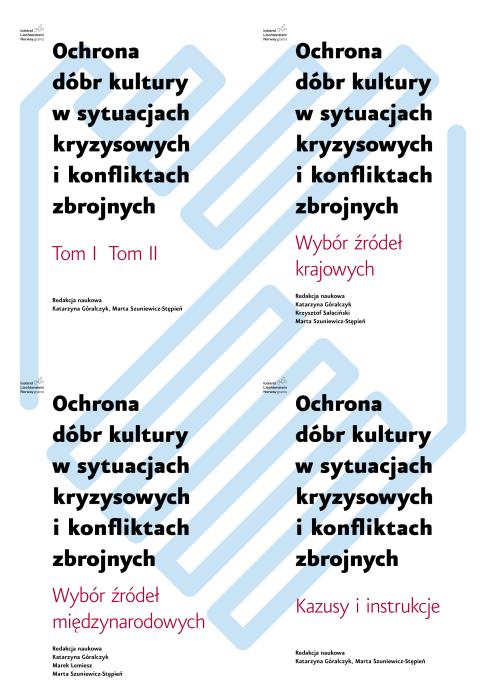Publication "Protection of cultural property in crisis situations"

Publications: "Protection of Cultural Property in Emergencies and Armed Conflict. Monograph. Volume I and II" and "Protection of Cultural Property in Crisis Situations and Armed Conflicts. Kazusy i instrukcje", edited by Katarzyna Góralczyk and Marta Szuniewicz-Stępień, as well as "Protection of cultural property in crisis situations and armed conflicts. A Selection of Domestic Sources" edited by Katarzyna Góralczyk, Krzysztof Sałaciński and Marta Szuniewicz-Stępień and "Protection of Cultural Property in Crisis Situations and Armed Conflicts. A selection of international sources ", edited by Katarzyna Góralczyk, Marek Lemiesz and Marta Szuniewicz-Stępień, are the result of the work of experts in the field of heritage protection and are the aftermath of the project: "Intersectoral Challenges: specialist in the protection of cultural heritage in case of crisis and war - development of a programme of postgraduate studies dedicated to professionals working at the borderline of fields", implemented from 2020 to 2022 in partnership by three institutions: Villa Decius Association (leader), the Bohaterów Westerplatte Naval Academy in Gdynia and the Villa Decius Institute for Culture.
The protection of cultural property, understood as caring for it in peacetime and securing it in times of crisis or armed conflict, obliges those involved and outsider users to specific actions adapted to the time and circumstances. Experience shows that the effectiveness of rescue operations depends on the degree of preparation and training of the owners, managers and users of historic buildings and the staff of institutions collecting cultural assets. It is crucial that the objects, collections and the personnel dealing with them are properly prepared to meet the threats and challenges posed by diverse and difficult-to-predict emergencies and armed conflicts.
The project worked on the issue in a comprehensive manner, taking into account both the civilian and uniformed services perspective. The project developed: a postgraduate programme in the indicated area, a set of publications and a training offer available outside the studies.
The interdisciplinary study programme, planned for 196h, is the fruit of the work of a team of experts from various fields, the set of publications includes very extensive source material: two volumes of monograph-book, two volumes of national and international legal acts and a collection of case studies and manuals.
It is hoped that the publications prepared will provide a useful compendium, organising and expanding knowledge in such a vast and complex field as the protection of cultural property.
The project was implemented within the framework of the Education Programme, funded by the European Economic Area Financial Mechanism 2014-2021. The project benefited from funding of €155,550 received from Iceland, Liechtenstein and Norway and €27,450 received from the Polish state budget.
The protection of cultural property, understood as caring for it in peacetime and securing it in times of crisis or armed conflict, obliges those involved and outsider users to specific actions adapted to the time and circumstances. Experience shows that the effectiveness of rescue operations depends on the degree of preparation and training of the owners, managers and users of historic buildings and the staff of institutions collecting cultural assets. It is crucial that the objects, collections and the personnel dealing with them are properly prepared to meet the threats and challenges posed by diverse and difficult-to-predict emergencies and armed conflicts.
The project worked on the issue in a comprehensive manner, taking into account both the civilian and uniformed services perspective. The project developed: a postgraduate programme in the indicated area, a set of publications and a training offer available outside the studies.
The interdisciplinary study programme, planned for 196h, is the fruit of the work of a team of experts from various fields, the set of publications includes very extensive source material: two volumes of monograph-book, two volumes of national and international legal acts and a collection of case studies and manuals.
It is hoped that the publications prepared will provide a useful compendium, organising and expanding knowledge in such a vast and complex field as the protection of cultural property.
The project was implemented within the framework of the Education Programme, funded by the European Economic Area Financial Mechanism 2014-2021. The project benefited from funding of €155,550 received from Iceland, Liechtenstein and Norway and €27,450 received from the Polish state budget.

